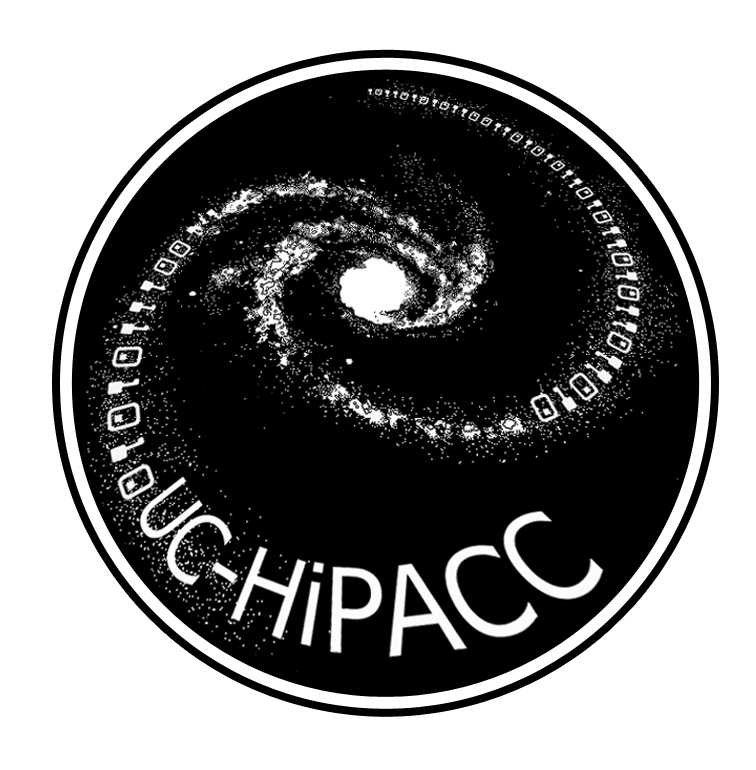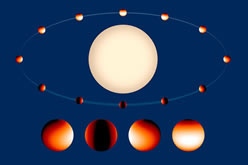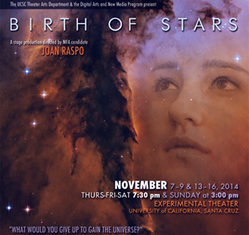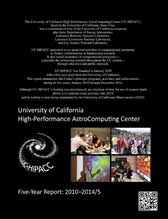The purpose of the University of California High-Performance AstroComputing Center (UC-HiPACC) is to realize the full potential of the University of California world class resources in computational astronomy. Read the letter from the Director
UC-HiPACC’s Five Years: Accomplishments and Legacy
The five-year report of UC-HiPACC’s impressive achievements 2010–2014 is now available here. A no-cost extension to HiPACC’s original five-year grant is allowing residual unspent funds to continue the AGORA project into summer 2015. This UC-HiPACC website—including its 650+ videos of talks and simulations and all 21 AstroShorts—will remain live as a lasting legacy and reference. Thanks to everyone who participated and made it possible!
UC-HiPACC Funding Discontinued
Funding has not been renewed for 2015 and beyond for the five-year-old University of California High-Performance AstroComputing Center (UC-HiPACC). UC-HiPACC’s major programs are therefore suspended. Alternative sources of funding are now being sought. Meantime, a No-Cost Extension to the grant has been approved through March 31, 2015, to support limited operations, including the pioneering AGORA research effort, preparation of a five-year report, and crafting of proposals for outside support. Pending receipt of alternative funding, some suspended programs may be resumed. For details, see UC-HiPACC press release.
posted: 2014-12-18 16:47:16
December 2014 AstroShort: Wild Weather on WASP-43b
Just in: Weather report for a ‘hot Jupiter’ 260 light-years away: more hellish than Mercury (iron would melt into puddles), because it is more humid—yes, there is water vapor in its atmosphere. And watch out for those howling scorching winds… Read “Wild Weather on WASP-43b,” UC-HiPACC’s latest AstroShort. Find us on Facebook and follow us on Twitter.
posted: 2014-12-03 07:10:25
Do jets spread Ebola? So long, Smokey—or die; Arctic bad news; souping up clouds; modeling A-bombs; where’s the oil?
Living with wildfires; Ebola, cancer, and supercomputers predicting drug side effects; the data are in—the Arctic is warming faster than modeled; fish gotta swim (even in drought); souping up Pleiades and hyperwall; monitoring ocean biodiversity and desert flash floods; two new institutes founded; move over, transistor; gold-water battery; and finding 2 million barrels of lost oil in an unexpected place. Read these stories and more in the
UC-HiPACC Data Science Press Room. Find us on Facebook and follow us on Twitter.
Calling all cosmic rays! No snack for Milky Way’s black hole. Why do we even exist?

Calling all cosmic rays…. Calling all cosmic rays…
What evidence for life on Earth? Depriving Milky Way’s supermassive black hole of a snack (and place your bets about its gas). Detect cosmic rays with your smartphone (psst! wanna be a coauthor?). CAT-scanning the adolescent universe; the Sun’s loopy transition region; secret to existence in Italy’s deep freeze; and POLARBEAR doing the B-twist. Recent research stories now posted in UC-HiPACC’s
Computational Astronomy Press Room. Find us on Facebook, follow us on Twitter.
Obsolescence of humans, meaning of life, invention and genius
Are humans obsolete? Student inventors do battle at CalHacks and Silicon Beach; star birth and the meaning of life explored on stage; “smartening” up the electric grid; and igniting children’s genius—read these latest stories in UC-HiPACC’s
Education and Public Outreach Press Room. Find us on Facebook and follow us on Twitter.



 Calling all cosmic rays…. Calling all cosmic rays…
Calling all cosmic rays…. Calling all cosmic rays…










